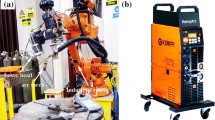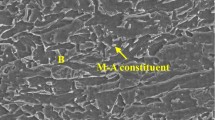Abstract
The objective of this study is to compare and contrast the differences in microstructure and fracture mechanism between CGHAZ of laser welding and submerged arc welding in X100 pipeline steel. The single-pass welding thermal simulation test of laser welding and submerged arc welding was carried out in MMS-200 thermal simulation test machine using self-made fixtures. The results indicated that the microstructure of laser welding CGHAZ and submerged arc welding CGHAZ was lath martensite and granular bainite, respectively. The impact energy of laser welding CGHAZ was 27 J, and the fracture mode was ductile fracture; the impact energy of submerged arc welding CGHAZ was 7.7 J, and the fracture mode was brittle fracture. The nucleation and propagation mechanism of cracks in different welding modes was established. Microcracks nucleated at the position of dislocation accumulation and remained austenite suppressed crack nucleation in laser welding CGHAZ. The nucleation site was at the M–A constituents in submerged arc welding CGHAZ. The main crack of laser welding CGHAZ was formed by one or a small number of microcracks. The main crack in submerged arc welding CGHAZ was formed by a large number of microcracks. The difference between crack nucleation and propagation mechanism is the reason why the impact energy of laser welding CGHAZ is higher than of submerged arc welding CGHAZ.













Similar content being viewed by others
References
S.K. Sharma and S. Maheshwari, A Review on Welding of High Strength Oil and Gas Pipeline Steels, J. Nat. Gas. Sci. Eng., 2016, 38, p 203–217
M.C. Zhao, K. Yang, and Y.Y. Shan, The Effects of Thermo-Mechanical Control Process on Microstructures and Mechanical Properties of a Commercial Pipeline Steel, Mater. Sci. Eng. A, 2002, 335, p 14–20
I.D.S. Bott, L.F.G.D. Souza, J.C.G. Teixeira et al., High-Strength Steel Development for Pipelines: A Brazilian Perspective, Metall. Mater. Trans. A, 2005, 36, p 443–454
C.W. Li, Y. Wang, T. Han et al., Microstructure and Toughness of Coarse Grain Heat-Affected Zone of Domestic X70 Pipeline Steel During In-Service Welding, J. Mater. Sci., 2011, 46, p 727–733
X.D. Li, Y.R. Fan, X.P. Ma et al., Influence of Martensite-Austenite Constituents Formed at Different Intercritical Temperatures on Toughness, Mater. Des., 2015, 67, p 457–463
J. Nowacki and P. Rybicki, The Influence of Welding Heat Input on Submerged Arc Welded Duplex Steel Joints Imperfections, J. Mater. Process. Technol., 2005, 164–165, p 1082–1088
S. Shen, I.N.A. Oguocha, and S. Yannacopoulos, Effect of Heat Input on Weld Bead Geometry of Submerged Arc Welded ASTM A709 Grade 50 Steel Joints, J. Mater. Process. Technol., 2012, 212, p 286–294
L.Y. Lan, C.L. Qiu, D.W. Zhao et al., Microstructural Characteristics and Toughness of the Simulated Coarse Grained Heat Affected Zone of High Strength Low Carbon Bainitic Steel, Mater. Sci. Eng. A, 2011, 529, p 192–200
P.S. Zhou, B. Wang, L. Wang et al., Effect of Welding Heat Input on Grain Boundary Evolution and Toughness Properties in CGHAZ of X90 Pipeline Steel, Mater. Sci. Eng. A, 2018, 722, p 112–121
C.L. Davis and J.E. King, Cleavage Initiation in the Intercritically Reheated Coarse-Grained Heat-Affected Zone: Part I. Fractographic Evidence, Metall. Mater. Trans. A, 1994, 25, p 563–573
P. Mohseni, J.K. Solberg, M. Karlsen et al., Cleavage Fracture Initiation at M–A Constituents in Intercritically Coarse-Grained Heat-Affected Zone of a HSLA Steel, Metall. Mater. Trans. A, 2014, 45, p 384–394
X.D. Li, X.P. Ma, S.V. Subramanian et al., EBSD Characterization of Secondary Microcracks in the Heat Affected Zone of a X100 Pipeline Steel Weld Joint, Int. J. Fract., 2015, 193, p 131–139
H. Xie, L.X. Du, J. Hu et al., Effect of Thermo-Mechanical Cycling on the Microstructure and Toughness in the Weld CGHAZ of a Novel High Strength Low Carbon Steel, Mater. Sci. Eng. A, 2015, 639, p 482–488
Y.L. Zhou, T. Jia, X.J. Zhang et al., Microstructure and Toughness of the CGHAZ of an Offshore Platform Steel, J. Mater. Process. Technol., 2015, 219, p 314–320
F. Vollertsen, S. Grünenwald, M. Rethmeier et al., Welding Thick Steel Plates with Fiber Lasers and GMAW, Weld. World, 2010, 54, p R62–R70
A. Unt and A. Salminen, Effect of Welding Parameters and the Heat Input on Weld Bead Profile of Laser Welded T-Joint in Structural Steel, J. Laser Appl., 2015, 27, p S29002-1–S29002-8
P.F. Guo, X.N. Wang, G.H. Zhu et al., Microstructures and Properties of X100 Pipeline Steel Joints by Fiber Laser Welding, Chin. J. Lasers, 2017, 44, p 1202003-1–1202003-8
G. Spanos, R.W. Fonda, R.A. Vandermeer et al., Microstructural Changes in HSLA-100 Steel Thermally Cycled to Simulate the Heat-Affected Zone During Welding, Metall. Mater. Trans. A, 1995, 26, p 3277–3293
L.Y. Lan, X.W. Kong, C.L. Qiu et al., Characterization of Coarse Bainite Transformation in Low Carbon Steel During Simulated Welding Thermal Cycles, Mater. Chart., 2015, 105, p 95–103
X.D. Li, X.P. Ma, S.V. Subramanian et al., Structure–Property–Fracture Mechanism Correlation in Heat-Affected Zone of X100 Ferrite-Bainite Pipeline Steel, Metall. Mater. Trans. E, 2015, 2, p 1–11
P. Haušild, I. Nedbal, C. Berdin et al., The Influence of Ductile Tearing on Fracture Energy in the Ductile-to-Brittle Transition Temperature Range, Mater. Sci. Eng. A, 2002, 335, p 164–174
M. Shome, Effect of Heat-Input on Austenite Grain Size in the Heat-Affected Zone of HSLA-100 Steel, Mater. Sci. Eng. A, 2007, 445–446, p 454–460
D.A. Curry, Cleavage Micromechanisms of Crack Extension in Steels, J. Mater. Sci., 1980, 14, p 319–326
F. Cleri, S. Yip, D. Wolf et al., Atomic-Scale Mechanism of Crack-Tip Plasticity: Dislocation Nucleation and Crack-Tip Shielding, Phys. Rev. Lett., 1997, 79, p 1309–1312
A.W. Thompson and J.F. Knott, Micromechanisms of Brittle Fracture, Metall. Mater. Trans. A, 1993, 24, p 523–534
A. Pineau, Development of the Local Approach to Fracture over the Past 25, Int. J. Fracture, 2006, 138, p 139–166
X.G. Zhang, G. Miyamoto, Y. Tojib et al., Orientation of austenite reverted from martensite in Fe-2Mn-1.5Si-0.3C alloy, Acta Mater., 2018, 144, p 601–612
Y.B. Xu, Z.P. Hu, Y. Zou et al., Effect of Two-Step Intercritical Annealing on Microstructure and Mechanical Properties of Hot-Rolled Medium Manganese TRIP Steel Containing δ-Ferrite, Mater. Sci. Eng. A, 2017, 688, p 40–55
J. Hu, L.X. Du, G.S. Sun et al., The Determining Role of Reversed Austenite in Enhancing Toughness of a Novel Ultra-Low Carbon Medium Manganese High Strength Steel, Scr. Mater., 2015, 104, p 87–90
J. Hu, L.X. Du, W. Xu et al., Ensuring Combination of Strength, Ductility and Toughness in Medium-Manganese Steel Through Optimization of Nano-Scale Metastable Austenite, Mater. Chart., 2018, 136, p 20–28
G. Lacroix, T. Pardoen, and P. Jacques, The Fracture Toughness of TRIP-Assisted Multiphase Steels, Acta Mater., 2008, 56, p 3900–3913
P.J. Gibbs, B.C.D. Cooman, D.W. Brown et al., Strain Partitioning in Ultra-Fine Grained Medium-Manganese Transformation Induced Plasticity Steel, Mater. Sci. Eng. A, 2014, 609, p 323–333
B.C.D. Cooman, P. Gibbs, S. Lee et al., Transmission Electron Microscopy Analysis of Yielding in Ultrafine-Grained Medium Mn Transformation-Induced Plasticity Steel, Metall. Mater. Trans. A, 2013, 44, p 2563–2572
J. Chen, M.Y. Lv, S. Tang et al., Correlation Between Mechanical Properties and Retained Austenite Characteristics in A Low-Carbon Medium Manganese Alloyed Steel Plate, Mater. Chart., 2015, 106, p 108–111
Y. Zou, Y.B. Xu, Z.P. Hu et al., Austenite Stability and Its Effect on the Toughness of a High Strength Ultra-Low Carbon Medium Manganese Steel Plate, Mater. Sci. Eng. A, 2016, 675, p 153–163
Z.J. Xie, S.F. Yuan, W.H. Zhou et al., Stabilization of Retained Austenite by the Two-Step Intercritical Heat Treatment and Its Effect on the Toughness of a Low Alloyed Steel, Mater. Des., 2014, 59, p 193–198
E. Bouyne, H.M. Flower, T.C. Lindley et al., Use of EBSD Technique to Examine Microstructure and Cracking in a Bainitic Steel, Scr. Mater., 1998, 39, p 295–300
Z. Guo, C.S. Lee, and J.W. Morris, On Coherent Transformations in Steel, Acta Mater., 2004, 52, p 5511–5518
X.L. Wang and Z.Q. Wang, New Insights Into the Mechanism of Cooling Rate on the Impact Toughness of Coarse Grained Heat Affected Zone from the Aspect of Variant Selection, Mater. Sci. Eng. A, 2017, 704, p 448–458
D.A. Curry and J.F. Knott, Effect of Microstructure on Cleavage Fracture Toughness of Quenched and Tempered Steels, J. Mater. Sci., 1979, 13, p 341–345
Acknowledgments
This research was supported by the Natural Science Foundation of China (51775102). Professor R. D. K. Misra acknowledges continued collaboration with the Northeastern University by providing guidance in language as an honorary professor.
Author information
Authors and Affiliations
Corresponding authors
Additional information
Publisher's Note
Springer Nature remains neutral with regard to jurisdictional claims in published maps and institutional affiliations.
Rights and permissions
About this article
Cite this article
Qi, X., Di, H., Sun, Q. et al. A Comparative Analysis on Microstructure and Fracture Mechanism of X100 Pipeline Steel CGHAZ Between Laser Welding and Arc Welding. J. of Materi Eng and Perform 28, 7006–7015 (2019). https://doi.org/10.1007/s11665-019-04412-5
Received:
Revised:
Published:
Issue Date:
DOI: https://doi.org/10.1007/s11665-019-04412-5




